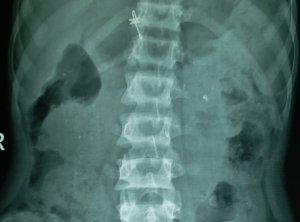This is a case scenario of a 19 years old female patient who was admitted to our hospital for bilateral lower limbs weakness. Viewers are advised to read the case scenario and suggest a possible diagnosis or a differential diagnosis. Answers and discussion of the case will be posted after a few days.
Case Presentation:
A 19 years of age female student, a resident of Kashmir was brought to the medical OPD with ten days’ history of bilateral lower limbs weakness.
Ten days back, the patient developed lower limb weakness, which progressively worsened over time and she became bed bound. There was no history of trauma, loss of consciousness, seizures, urinary retention or bowel complaints.
The patient denied any previous history of similar episodes. The systemic inquiry is unremarkable.

On examination, the patient was a short-statured, lean patient, well oriented and cooperative. Vitals signs of the patient were stable. There was no pallor or icterus but she had knocked knees.
Neurological examination of the lower limbs revealed hypotonia and reduced power in both the lower limbs (both proximal and distal muscles power was 2/5). She had normal reflexes and a normal sensory examination. Cranial nerves examination and fundoscopy were normal.
Other system examination was unremarkable.
Investigations for bilateral lower limbs weakness
Her Baseline investigations were done.
Blood CP: Normal,
Liver function tests: ALT: 18 U/l (normal), Alkaline phosphatase of 244 U/l (normal 35 to 110 U/L),
Renal Function tests: Creatinine: 1.8 mg/dl (0.2-1.2 mg/dl), urea: 80 mg/dl (normal 13 – 40 mg/dl) ,
Serum Potassium was 1.9 mEq/l,
Serum Sodium of 136 mEq/l
Serum Bicarbonate of 11.6 mEq/l,
Serum chloride: 112 mEq/l,
Arterial PH: 7.2
Urine RE: PH: 7.0, 10 RBCs, 1 + proteins
Serum Calcium and Serum Phosphate levels were normal
Radiological workup of the patient with bilateral lower limbs weakness



Questions:
- What is the possible diagnosis/ differential diagnosis?
- How should we manage this patient?

Answers:
This is a case of distal Renal tubular acidosis or Type 1 Renal tubular acidosis
Reasons: Patient has normal anion gap metabolic acidosis with a disproportionately high urinary PH, Hypokalemia and Nephrocalcinosis.
Management of the patient includes therapy with an alkaline agent like sodium bicarbonate and replacing potassium and citrate.
A discussion on Renal Tubular acidosis will be posted soon!